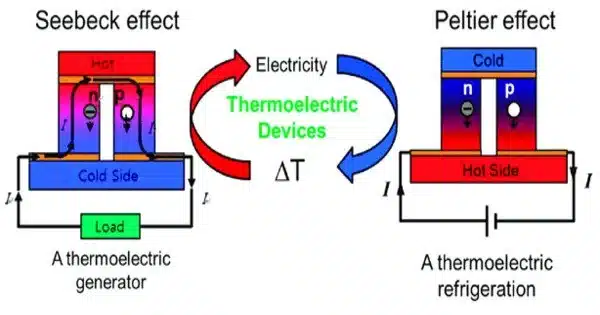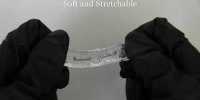The thermoelectric effect is the direct conversion of temperature differences to electric voltage and vice versa through the use of a thermocouple. A thermoelectric device generates a voltage when the temperature on each side differs. Heat is transferred from one side to the other when a voltage is applied to it, resulting in a temperature difference. An applied temperature gradient causes charge carriers in the material to diffuse from the hot side to the cold side at the atomic scale.
The thermoelectric effect is the phenomenon of generating an electrical potential difference (voltage) across a conductor when its two ends are at different temperatures. Thomas Johann Seebeck discovered this effect in 1821. This effect has the potential to generate electricity, measure temperature, and change the temperature of objects. Because the applied voltage affects the direction of heating and cooling, thermoelectric devices can be used as temperature controllers.
The presence of a temperature gradient across a material with both electrical and thermal conductivity causes the thermoelectric effect. When there is a temperature gradient, charge carriers (electrons or holes) flow through the material, creating a potential difference between the hot and cold ends of the conductor. The Seebeck coefficient is the potential difference that is proportional to the temperature difference.
The Seebeck coefficient is a material-specific property that depends on the chemical composition and crystal structure of the material. Materials with a large Seebeck coefficient are called thermoelectric materials and are used in thermoelectric generators to convert heat directly into electrical power.
Application
The thermoelectric effect has a wide range of applications, including power generation, temperature sensing, and cooling. For example, thermoelectric coolers use the Peltier effect (the reverse of the Seebeck effect) to create a temperature difference across a junction between two dissimilar materials when a current is passed through them, resulting in cooling of one side and heating of the other.
The thermoelectric effect allows waste heat to be converted into electric power. There are already commercial thermoelectric wristwatches that take advantage of the temperature difference between the body and the surrounding environment. Higher solar-to-electricity conversion efficiency can be achieved by combining thermoelectric and PV effects.
















